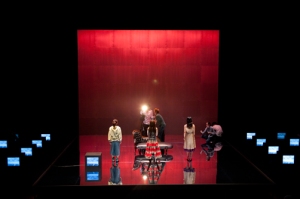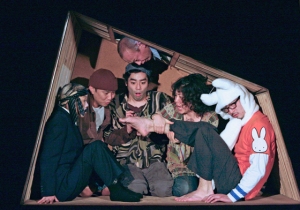Elfriede Jelinek’s drama texts are a challenge to any theatre director because they are completely open to all interpretations. The writer provides no “characters” or “plot”, let alone stage directions, so there is nothing there for the director to determine the way in which they should be staged. Surely, Jelinek’s series of plays prompted by the nuclear accident at Fukushima – “Fukushima –Epilog” and “Kein Licht.” – were not written with the Japanese stage in mind. Those texts are there for anyone to direct, and they have actually already been staged – in Cologne (2011), Salzburg (2012) and recently in Vienna and Graz. But since the Japanese were affected by the disaster directly, there is indeed a kind of expectation that Japanese directors would be the ones to make the most out of these plays.
It must be said from the start that Jelinek‘s plays are not meant to be enjoyable. They have a quality of addressing the listener directly: provoking the audience with outrage, anger and irony. In “Prolog?” the author seems to take on the role of a “shaman”, a medium-like presence, bringing to light the voices which otherwise would be left unheard. However, these voices are not, so to speak, “characters”. For instance, in Jelinek’s dialogue between “me” and “you”, between the accuser and the accused, between victim and perpetrator, the boundary is very thin, almost indiscernible. With no characters and no narrative, the text is completely open. The director is free to choose the number of characters he brings on stage, the theatrical genre or method he employs (“Kein Licht.” was a “Sprechoper” on the Austrian stage, for example), and he can even choose which part of the play he would like to focus on in order to emphasize certain aspects of the content. That is why Akio Miyazawa’s attempt to stage “Prolog?” with the means of Noh theatre, unarguably the most “formal” performing art extant in Japan, has been a most inspired one.
First and foremost, the stage borrows the structure of a Noh stage, with its typical hashigakari – a prolongation that connects the stage with the left side of the backstage. In mugen nō (“dream Noh”), which is probably the most popular category of Noh plays, the main character is usually a ghost appearing in a traveler’s dream. Here the hashigakari is seen as the path that connects “this world” with the “other world”, the place where the ghost is coming from. In other words, right from the beginning of the performance, just by seeing the structure of the stage, we already receive a hint about the key in which Miyazawa interpreted the dramatic text: the characters will most probably be apparitions, souls of the dead wandering around unappeased. In fact, the director went a step further by covering the stage in dirt, making it look like a burial ground.
In this tension-laden space the bodies of the five actresses enter slowly, in a slow tempo reminding us again of Noh. As they take over their roles, they go in and out of the slow tempo. All the actresses get their turn to speak, but just like in Noh theatre, the performers are responsible for roles, they do not represent characters. Their roles and their lines are handed over from one to the other, suggesting the image of a sea of voices–as one voice comes into the forefront, the others fade out. As to what they say, their lines are fragments of statements, words of resentment, disrupted dialogues and shouts – directed toward the audience rather than to each other.

F/T13 Jelinek series: Prolog?, directed by Akio Miyazawa (Tokyo Metropolitan Theatre, Nov 30th – Dec 8th)
Among them all there is a particular phrase that is repeated over and over again: “The staging will fail!” In German, there is the same word for “staging” and “representation” – “Darstellung” and the Japanese translation of the work (by Tatsuki Hayashi) uses both words, well aware that the dual nuance is important for the meaning of the play. Director Miyazawa focuses on “staging”, a self-mocking allusion to the performance for which he is responsible. However, these words are meant to be a menacing prediction which definitely cannot mean only the staging of the play itself. If we think about the tension that is the theme of this play, the tension between representation of reality and reality itself, then it becomes clear that Jelinek’s prophecy has a long range. Although written as the last in her series of texts triggered by the nuclear disaster as an extension of “Kein Licht.”, this work is a “prologue” because it is a prophecy. It predicts that the scenario that the authorities in power are putting up will fail, because no one will believe a representation of reality that is fake.
By using the space and the basic ideas regarding movement and tempo from Noh theatre, Miyazawa manages to give form to a dramatic text that is open-ended, making it possible for it to be staged and its message conveyed. It is only with a directorial approach that this work becomes complete and performable. However, the director seems to be fully aware that it would be a mistake to force the formality of Noh theatre into Jelinek’s text. That is why the form is powerfully disrupted at a certain moment, when the actresses dance frenetically to very loud and high-paced hard rock – the ultimate expression of rage and counter-reaction to a state of affairs that is imposed on the individual.
When faced with a dramatic text, there are several options for the theatre director. One can respect the original meaning and intent of the play, but interpret it as originally as possible, conferring one’s own “colors” on it through the staging. The second option is to completely dismantle it and take an opposing stance towards the playwright, turning the meaning of the text upside down. Or, the third option is that the director can do everything in his powers to render the message of the play as accurately as possible, paying respect to the auctorial voice.
After a careful and in-depth reading of “Prolog?”, Miyazawa has managed to ensure that Jelinek’s voice takes the foreground and reaches the audience. The author speaking on behalf of the dead possessed only words at first, but the bodies of the five actresses and the “form” borrowed from Noh theatre now make the work complete, functioning as means for that voice from beyond to come out and reach us, the audience. It is a powerful, provocative voice, calling out for us to keep questioning the validity of the images and representations that are imposed on us.
(* This article has first appeared on the “Blog Camp in F/T” platform, a Festival/Tokyo 2013 program for young critics lead by performing arts journalist Iwaki Kyoko, and was reblogged with permission.)




